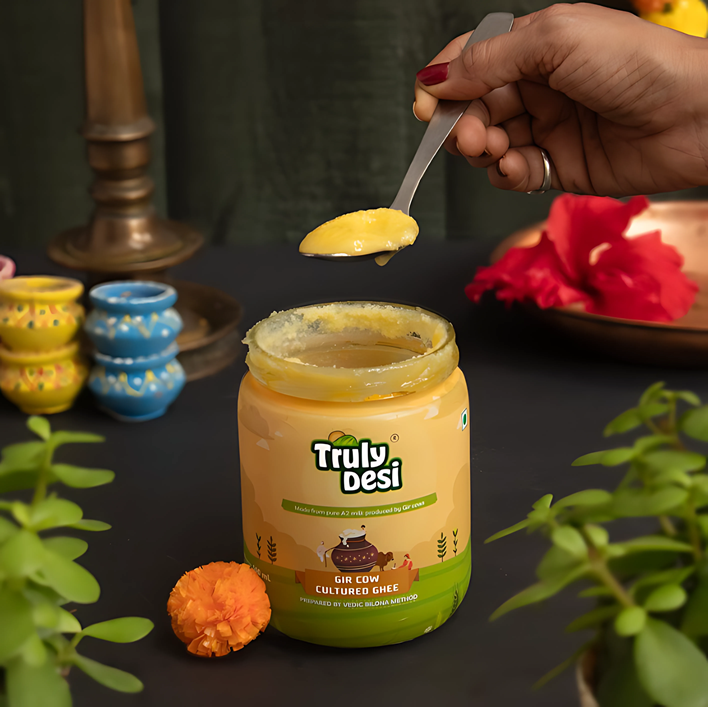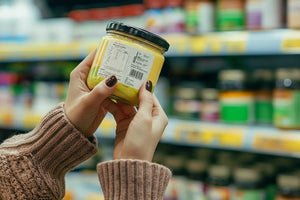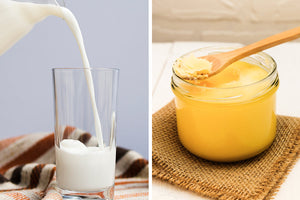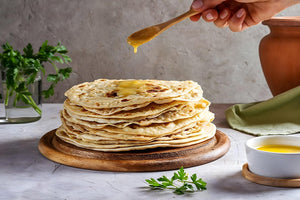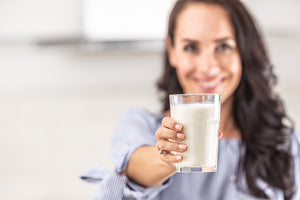
Ghee vs Butter: What is the Difference?
Ghee and butter have long been a part of Indian homes. Both are rich, flavourful, and widely used in everyday meals. But many still wonder — what is the difference between ghee and butter? This blog helps you explore their qualities, preparation methods, and roles in Indian cooking — without comparing them competitively.
1. What is Butter?
Butter is made by churning fresh cream. It contains a mix of water, milk solids, and fat. Soft, smooth, and creamy — it’s often used as a spread, in baking, or to enrich gravies. In Indian households, butter is loved for its comforting taste and texture.
2. What is Ghee?
Ghee is a form of clarified butter. It is made by slowly heating butter to remove water and milk solids. This leaves behind a golden liquid fat — known for its rich, nutty aroma. Ghee has deep roots in Indian cooking, rituals, and Ayurveda.
3. Difference Between Butter and Ghee
Understanding the butter and ghee difference helps you know where each one fits best. Here’s a simplified breakdown:
|
Aspect |
Butter |
Ghee |
|
Source |
Made by churning cream or curd |
Made by heating and clarifying butter |
|
Water Content |
Contains water |
Water is removed |
|
Milk Solids |
Present |
Removed during preparation |
|
Lactose & Casein |
Contains both |
Typically removed, making it suitable for lactose-sensitive individuals |
|
Texture |
Solid and creamy |
Liquid or semi-solid depending on room temperature |
|
Taste |
Mild, creamy flavor |
Rich, nutty flavor |
|
Smoke Point |
Lower (approx. 150°C) |
Higher (approx. 250°C) |
|
Shelf Life |
Needs refrigeration |
Longer shelf life, can be stored at room temperature |
|
Use in Cooking |
Best for baking, spreading, low-heat cooking |
Ideal for frying, sautéing, and traditional Indian dishes |
|
Cultural Significance |
Popular in Western cuisines |
Integral to Indian cooking and Ayurveda |
|
Digestibility |
Can be heavier for some |
Easier to digest, especially in Ayurvedic practices |
4. Butter and Ghee in Indian Kitchens
In Indian cuisine, both butter and ghee hold a special place.
- Butter adds creaminess to parathas, gravies, toast, and baking.
- Ghee is used in tadkas, sweets, cooking, and even spiritual practices.
Their flavour profiles and cooking properties may differ, but both contribute to taste and tradition.
5. Ghee and Butter in Health and Wellness
When it comes to wellness, both butter and ghee have their own characteristics.
- Ghee is often seen in Ayurveda as nourishing and easier to digest.
- Butter is rich in fat-soluble vitamins and has a long-standing role in traditional diets.
Whether you're looking for comfort or a particular cooking method, it's worth understanding how each supports your lifestyle and taste preferences.
6. Clarifying the Common Queries
Let’s answer a few common questions to help you decide how to use both:
Q. What is the difference in ghee and butter?
Ghee is clarified butter. It has no water or milk solids and can withstand higher cooking temperatures.
Q. Is butter and ghee the same?
No, while ghee comes from butter, the final composition, taste, and texture are different.
Q. Which is healthier – butter or ghee?
Health value can vary based on diet, digestion, and cooking needs. Both can be part of a balanced diet when used in moderation.
7. Choosing What Works for You
At Truly Desi, we believe in celebrating both — ghee and butter — in their purest, most natural forms.
Each one has its place on your plate, in your recipe, and in your traditions.
Rather than comparing, it’s more useful to explore how both butter and ghee serve different purposes in the kitchen and beyond.
Whether it’s a dollop of butter on your hot roti or a spoon of ghee in your dal — enjoy the best of both worlds with Truly Desi.
Explore the Truly Desi Dairy Collection
We offer:
- A2 Desi Cow Ghee made using the traditional bilona method
- Farm-fresh White Butter with no preservatives or chemicals
Wholesome. Authentic. Delivered fresh to your doorstep.

